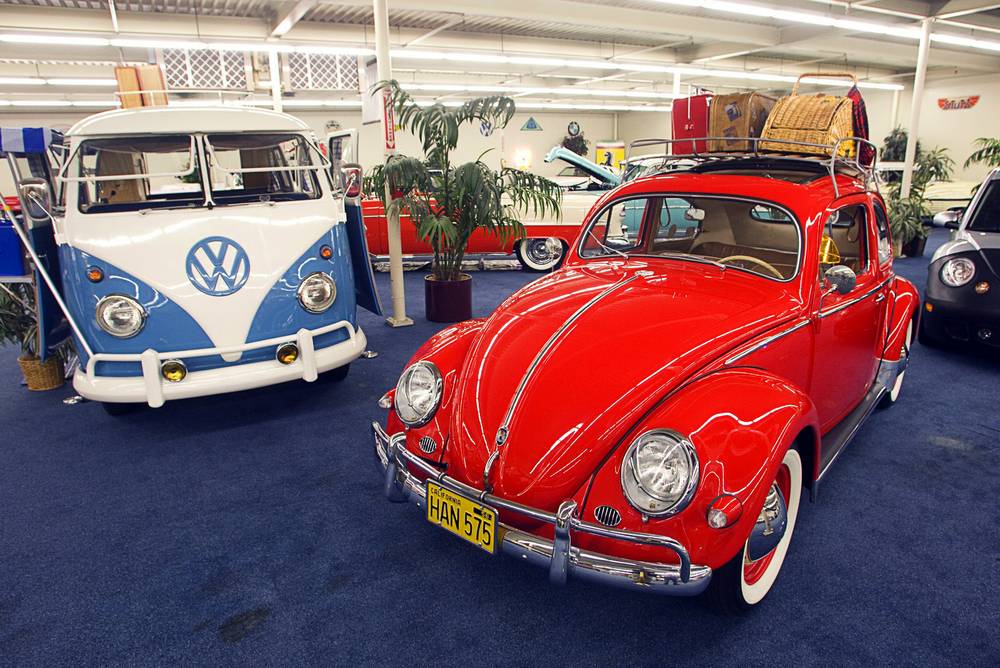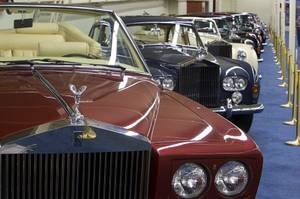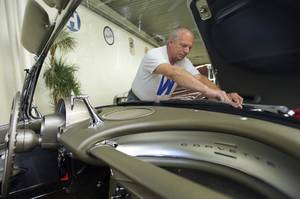Like card players, car collectors know when to hold and fold. They watch for the slightest tells and fanatically track case kings and top kickers. There’s money in the game. But the greats are in it for the chase, even if that means waiting decades, spending millions and crossing oceans just to hear the absolute purity of the door latch on a 1930 Duesenberg J.
Las Vegas Boulevard is a carnival of beautiful new cars, from sleek Audi R8s and Bentley Continental GTs to the comic book lines and gadgetry of the 16-cylinder Bugatti Veyron. They are specimens of modern engineering and design, but acquiring one is as easy as writing a check. That’s why you won’t see them in the world-class Auto Collections at the Imperial Palace, also known as “125,000 square feet of awesome.”
Mile one
Half museum, half specialty dealership, the Collections offer antiques and classics, custom hot rods, muscle cars, Pebble Beach Concours d’Elegance winners, exotics, hill climbers, rare motorcycles, prototypes, 100-point restorations, Indy 500 racers and pacers and anything else with wheels that’s collectible. It’s not the only impressive stockpile on the planet, but general manager Rob Williams believes there is no comparison when it comes to depth.
“Most places specialize in something,” he says. “We try to be good at everything.”
The “we” includes Williams’ father Don, who co-owns the Collections with partner Richie Clyne and a handful of investors who share their love of great cars and the endless hunt. But the original concept of a public auto shrine at the Imperial Palace belongs to Las Vegas legend Ralph Engelstad.
Engelstad was a self-made man who transformed the decaying Flamingo Capri into the Imperial Palace in 1979. One of the last independent casino owners on the Strip, he was also a philanthropist and a top-level collector of antique and classic cars. In 1981 he moved his enviable collection to a public showroom in the Imperial Palace and, over nearly two decades, built it into a flagship museum called the Auto Collection.
In addition to the largest concentration of Duesenbergs anywhere (52), the 1,000-car exhibit featured a Mercedes that once belonged to Hitler, part of a larger collection of Nazi memorabilia that Engelstad took heat for over the years. When he decided to step away from the Auto Collection in 1999, the time was right for a sea change, not only in leadership but also in the vision for what it could be.
The men who would be kings
Don Williams and Clyne were partnering on expos and auctions by then, and the Imperial Palace offered them the Auto Collection space for their own endeavor. As Clyne had been helping build the Collection since the day it went public, he and Williams agreed to help Engelstad find homes for his considerable inventory during the transition. But the more they moved the more they wanted to turn the outfit into a car buff’s Mecca not just for appreciating the best of the best, but also for buying and selling.
More
- History and Horsepower
- •There are three 1933 Pierce Arrow Silver Arrows in the world, and Don Williams has owned all of them.
- •Singer Jimmy Velvet recently was hanging out at the Auto Collections. At one time he owned 21 of Elvis’ cars, including a Mercedes limo that was a gift from the King. “He would give cars away like they were nothing, like they were chewing gum,” Velvet says.
- •The luck money visitors toss on a display of mannequins picnicking by an antique car translates to $500-$1,000 a month for organizations ranging from St. Jude’s and Susan G. Komen to local schools.
- •The 1930 Duesenberg J Murphy Town Car is one of four ever built and appeared in the Jimmy Stewart classic It’s a Wonderful Life.
- •The most popular car the Auto Collections has ever had is the 1967 Shelby Mustang GT500E Eleanor featured in the film Gone in Sixty Seconds. It is soon to return to the showroom.
The next year they combined their personal collections into one—the Auto Collections at the Imperial Palace—keeping only the 1939 Chrysler Royal Sedan Johnny Carson sold to Engelstad for $1 in 1994. The hybrid museum and specialty dealership now draws about a thousand visitors a day, a few of whom throw down serious money to drive away in jaw-droppers picked from polished rows of Shelby and Stutz, Chrysler and Cadillac. And the 150 cars on display account for only a fraction of their combined treasury of more than 500.
On Williams’ California-based Blackhawk Collection website, his bio claims that nearly every great car in existence has passed through his hands, backed up with a personal quote: “No one in the world can afford to buy them all. I just want to touch them all once.”
From a humble start as a classic car salesman, Williams has become one of the foremost innovators in the collecting world. In 1981 he was the first to sell a classic car for more than $1 million. In 1988 he presented the first American-style auto auction in Europe. And in 1992 his Blackhawk Collection was the first to achieve $100 million in private sales. Today he is contributing to the first dedicated car museum in China.
Clyne is equally decorated. In 2004 he was inducted into the Southern Nevada Sports Hall of Fame for his “brainchild,” the Las Vegas Motor Speedway. In the early ’90s, he pioneered a training program for inmates at the Southern Desert Correctional Center that taught them the essentials of auto restoration, and in 2002, he opened an antique car museum at the St. Jude’s Ranch for Children in Boulder City, with all proceeds supporting disadvantaged youths.
He bought his first car—a 1930 Ford Model A—at age 12, which he fixed up in high school and still drives.
“There’s no difference between a beautiful car or a beautiful building or a new home you want to buy. It’s all in the pursuit,” Clyne told Barry Meguiar in a classic episode of Car Crazy. “Then again, once you’ve had it for about a month, a car you’ve chased for 20 years is just another can of corn on the shelf.”
New classic
Rob Williams might disagree. The Auto Collections include a fleet of his beloved Volkswagens, including one he chased for two decades.
Because it shares space with the brand heft of Ferrari and Rolls-Royce, you might not notice the ’57 Beetle at first. But the paint job alone is worth a gape, putting ripe cherries and candied apples to shame. It looks wet, like Chanel nail polish spilled on glass.
Williams first saw the car at a show in 1990. “It was the most beautiful VW I had ever seen,” he says, adding that he has owned 50. “I gave my business card to the owner and said I wanted to buy it. He looked at the card, flicked it on the ground and said, ‘Boy, you will never own this car.’”
In 1996 Williams heard a mint condition ’57 was up for auction and knew it was the same car. On the day of reckoning he was high bidder—until an arm went up a few rows in front of him. It was Ralph Engelstad.
“I couldn’t bid against him, but I still got the satisfaction of having the car here,” Williams says. He even looked up the previous owner in California and called to remind him of their meeting in 1990 and share the good news.
Just last year, Williams finally bought the car for himself. From the way he talks about its 41 first place wins (and one second), you can tell the can of corn is solid gold. The business side of the Auto Collections is driven by such informed obsession, but impulse is just as powerful. A man recently won $50,000 at the Imperial Palace blackjack tables and had the concierge call the Collections at 4 a.m. about a 1972 Oldsmobile Cutlass Hurst. A few hours later the lucky winner paid cash and drove it home.
You’d have to win that amount 320 times over to offer on the Ford Gulf GT40 that won Le Mans in 1967. The $16 million price tag was listed when the car was part of the Auto Collections, but Williams says people wanted to violate it accordingly. He once caught a guy jumping through the window so his girlfriend could snap a photo.
“There are 20 cars over $1 million in here, but if you park them next to a 1965 Mustang, people will walk right by. They relate to the Mustang,” he says. “Classic cars are about nostalgia, whether it’s what you had when you were young or what you wish you had. For certain people it’s the history. And everyone has that friend or family member who used to have a car ‘just like that.’ Once the cars get in your blood it’s all over. It’s there forever, for life.”
Good hands, gearhead
With so much precious tonnage on the showroom floor, you’d think a fleet of mechanics lives in the utility closet.
In reality, it’s a lone part-timer who loves the craft—Bob “The Whiz” Dehnert. The nickname stems from his reputation for being able to fix anything.
“The guy could make a tomato run,” Williams says.
Dehnert knows a great deal about the tomato. He knows that the upholstery in a 1956 Lincoln should have double French-stitched leather piping; that the 1957 Eldorado Brougham’s magnetized cups and perfume atomizers don’t make it worth the nightmare of two miles of electrical wire; that in 1940 Packard only sold 15 cars with air conditioning because it accounted for 25 percent of the sticker. But his 40 years as a mechanic only show in his hands. His eyes are startlingly blue, matching the giant “W” on his T-shirt, and his silver hair is slicked straight back, emphasizing the lack of wrinkles on his 65-year-old face.
Dehnert grew up in Chicago and loved cars from boyhood, often sitting on the sidewalk and guessing what they were from the tone of the exhaust. His interest in automotive work grew as he did, but his father expected him to become an electrician. Six months into trade school and with top grades, Dehnert quit.
“I got to play with electrons and vacuum tubes, but gears and pistons were running through my head,” he says, adding that a friend who managed a Cadillac garage got him a job as an apprenticing mechanic. “I was making $60 a week and coming home looking like I worked in a coal mine. My dad had a fit. He confronted my boss, who told him, ‘Look, he’s got good hands and they’re connected to a gearhead.’”
Just as Dehnert was getting the hang of paint and bodywork on new cars, he crossed paths with a charismatic collector named Marv Cohen. Cohen was a well-known jeweler in Chicago and had a dozen antique cars. He asked Dehnert to come and work exclusively on his collection, to which Dehnert replied he would soon work himself out of a job.
Cohen immediately bought a dozen more cars, including three Duesenbergs and a 1948 Cadillac Series 62 Saoutchik—one of only two ever made—and promised Dehnert he would keep the larder stocked.
“Our deal was till death do us part, on a handshake,” Dehnert says. “It was the perfect job for the perfect man.”
With unlimited funds and a warehouse of stunners, Dehnert spent three days a week on restoration and two on maintenance. He worked for Cohen until the day he died, for more than 20 years.
“I had a 1965 Lincoln convertible when he hired me, but my little girl was born really sick, and I had to sell it to keep her alive. Marv bought my Lincoln and never drove it,” Dehnert says. “He was like a father.”
He still has the Lincoln, a 1960 Chrysler 300F and the ’66 Chevy Corvair Manza that Cohen gave Dehnert’s wife, Bonnie. He works at the Auto Collections every Monday, prepping sold cars and keeping the rest of the inventory in fighting shape for shows here and across the country.
While he’s just as fluent in Italian, German and French cars, Dehnert is a diehard fan of American automakers, especially Duesenberg. He riffs on its overbuilt chassis, dual overhead camshafts, hemispherical combustion chamber and four-valve cylinder. Fewer than 500 were built, and he has worked on many of the surviving 390.
“It’s really a high taking a car totally apart and working on every nut and bolt to make it look brand new and run even better,” he says. “I’ll probably die under a car.”
Hotwire
These days, guys like Dehnert are as rare as the roadsters and racecars they restore. Most mechanics rely on computers and whiz-bang engineering, as do drivers. The connection they once had to the road has faded into the pace of life and the ease of the 21st-century automobile.
Old cars force that connection. Idling in my dad’s ’64 Corvette Stingray, everything is engine. Shifting is tough because the gears are so tight, and the only “power” items are the windows, which a console plaque warns not to lower in excess of 120 mph. As Dehnert says, you have to listen and feel the car to know what it needs. In return, a trip to the gas station is thrilling.
Oddly enough, you can have that feeling in a Ford Festiva. As Don Williams says, all you need is “heart for the car.” If your heart beats only for one-of-a-kind gems, the Auto Collections is a chance to dream and swap stories with other dreamers (who have access to the keys).
“I can hear a 1962 Ferrari 250 Testarossa GTO coming. It’s almost like listening to a great song on the radio; you hear it and everything else tunes out,” Rob Williams says. “The sound of those cars opening up on the road—there’s nothing like it in the world.”




Previous Discussion: